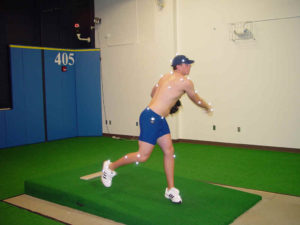 Stodden DF, Fleisig GS, McLean SP, Lyman SL, Andrews JR. Relationship of pelvis and upper torso kinematics to pitched baseball velocity. Journal of Applied Biomechanics 17(2):164-172, 2001.
Stodden DF, Fleisig GS, McLean SP, Lyman SL, Andrews JR. Relationship of pelvis and upper torso kinematics to pitched baseball velocity. Journal of Applied Biomechanics 17(2):164-172, 2001.
Matsuo T, Escamilla RF, Fleisig GS, Barrentine SW, Andrews JF. Comparison of kinematic and temporal parameters between different pitch velocity groups. Journal of Applied Biomechanics 17(1): 1-13, 2001.
Stodden, DF, Fleisig, GS, McLean, SP, Andrews, JR. Relationship of Biomechanical Factors to Basebal Pitching Velocity: Within Pitcher Variation. Journal of Applied Biomechanics 21(1): 44-56, 2005
Methods
In three published studies, Dr. Glenn Fleisig and Dr. James R. Andrews from ASMI worked with other researchers in studying many of the parameters that affect baseball pitch velocity. Two of the studies looked between different pitchers and one study looked at variations within each pitcher. Motions during delivery were analyzed using a high speed (200 frames per second) infrared three-dimensional motion analysis system.
Results
In the study by Matsuo and others, pitchers with higher ball velocity were compared with pitchers with lower ball velocity. Four significant differences were found between these two groups. Compared to the low ball velocity group, the higher ball velocity pitchers demonstrated less lead knee flexion velocity after front foot contact and greater lead knee extension velocity at the time of ball release. Extending the lead knee in this manner may provide stabilization allowing better energy transfer from the trunk to the throwing arm, and could be a critical factor in pitch velocity. Maximum shoulder external rotation and forward trunk tilt at ball release were also greater in the higher velocity group. Greater shoulder external rotation causes a stretch of the internal rotators allowing energy to be stored in these muscles, and creating greater internal rotation during the arm acceleration phase.
Two variations were found in the timing of events. Maximum elbow extension angular velocity and maximum shoulder internal rotation angular velocity occurred earlier in the motion of higher velocity pitchers. The maximum shoulder internal rotation angular velocity also occurred closer to the moment of ball release in the higher velocity pitchers. This optimal timing may aid in generating higher velocity pitches.
Another finding of interest is that early in the pitching motion, the two groups were dissimilar in the timing of their movements, while their later movement timing was much more similar. This implies that early trunk and torso movements are more varied among pitchers than late arm movements.
In the first study by Stodden and others (2001), pelvis and upper torso variables were studied in 19 elite baseball pitchers. The study found that when the arm was completely cocked back (that is, maximum shoulder external rotation, or "MER"), more "open" pelvis and upper torso orientation correlated with increased ball velocity. More open pelvis angle at the time of ball release (REL) also correlated with increased pitch velocity increased. Additionally, pelvis angular velocity from front foot contact to MER, and upper torso angular velocity from MER to REL increased with increased velocity.
The data indicate that a pitcher who is able to position himself properly, and rotate his pelvis and upper torso more quickly is able to generate greater momentum. Theoretically, this increase in momentum leads to greater velocity of the throwing arm and thus greater pitch velocity.
The most recent study by Stodden and others (2005) showed that for a given pitcher, increased elbow flexion torque, shoulder proximal force and elbow proximal force produced greater ball velocity. In addition, the maximum shoulder horizontal adduction occurred later and maximum shoulder internal rotation occurred earlier at greater ball velocities. Higher ball velocity also resulted in decreased shoulder horizontal adduction at foot contact, decreased shoulder abduction during acceleration, and increased trunk tilt forward at ball release.
Conclusion
A pitcher with increased shoulder external rotation, faster pelvis and upper trunk rotation, and greater front knee stabilization and extension will throw with greater ball velocity. Improved timing to maximize arm velocity closer to the time of ball release will also help ball velocity. Increased torque and force produced at both the shoulder and elbow will also lead to greater ball velocity.


Trackbacks/Pingbacks